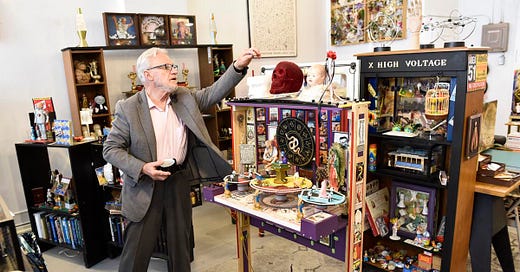By Brian D’Ambrosio
Kitsch is a German word meaning trashy or junky work of art, a synonym for tasteless item.
Barry Ferst, owner of Curiouser and Curiouser, revels in all stuff kitsch.
His kitsch art menageries are a good-humored, irreverent expression, poking fun at the world of poor, chintzy taste, mass-produced tackiness, and rampant consumerism. His collections – the stuffed cabinets, the stacked tables and overflowing drawers, the sawed-in half pinball machine chock full of rubbish – all of them embody kitsch.
“Kitsch is the gaudiness dominant in the things that we admire and desire,” said Barry Ferst. “Kitsch is the cultural yearnings of a consumer society.”
The broader universe of kitsch encompasses not just art, but objects or designs considered to be in cheap taste because of excessive garishness or vulgar sentimentality.
Some would say that the mediocrity of art, object, and design has become the nourishment of the masses – and, whether you agree or not, the tawdry and tasteless have undoubtedly provided great fodder for artists such as Ferst. The lava lamp would be an example of sixties kitsch. Seventies kitsch? Think pink pearl swan salt and pepper shakers or mushroom sugar canisters, or the flower-shaped clock in your grandmother’s kitchen, or perhaps your mother’s colorful enameled teakettles. Gnomes would be the most sterling example of contemporary kitsch.
“Today,” said Ferst, “one could walk into a big-box megastore and buy a Mona Lisa print for ten dollars. A Mona Lisa couch, her face emblazoned on a pair of lamps, with a set of Mona Lisa coasters on the end tables – that would be considered the complete modern kitsch set up.”
To be kitschy, it generally needs to be made from everyday, industrial material and mass-produced, ad infinitum. Miniatures of historic works such as the Eiffel Tower or Statue of Liberty – the stuff of tourist traps – are kitsch.
“In the late 19th Century, you see people using industrial items to make art. Marcel Duchamp presented a toilet bowl as a sculpture (in 1917). Andy Warhol started working with everyday imagery and multiples. America is consumerism. In some of my installations, you see three racers, or three heads, or three hot dogs, multiples of American everyday items, part of the tradition of kitsch.”
Ferst’s shop is a journey into the stadium of not just kitsch but the arena of urban folk art – installations rich in metropolitan imagery, buildings, lights, and density – as well as interactive folk art, systems with kinetic or motored or electric components. It’s the culmination of a lifetime interest that Ferst maintains in gathering and screening effects.
A retired Carroll College philosophy professor with 47 years’ of teaching to his tenure, Ferst comes from innovative, curious stock. His father was a trained architect; his uncle a first-rate draughtsman who compiled the drawings for the United Nations Secretariat Building in New York City and designed other projects all over the world.
“When I was going off to college, my dad said I could study what I wanted,” said Ferst. “But he requested that I do two things for him: learn about art and copy it. This was during the time of hard-edge pop art. I read about art, and I tried oils and acrylics, but I liked assembling things and liked showing things. I wanted to show American kitsch, and elevate it. I wanted to show things and elevate it into an art object. It’s up to the viewer if that works or not.”
Ferst said that he started constructing kitschy art boxes sometime around 1978. He came to Helena in 1980 for a non-tenured teaching position at Carroll College.
“My wife and I fell in love with the city and three years later the dean said I could apply for tenure,” said Ferst.
Ferst’s Curiouser and Curiouser is both a gallery and a museum and a social, intellectual medium, a big, sprawling assemblage of curiosity cabinets, all total comprised of hundreds of discarded, abandoned, forsaken components, from game cards and doll parts, to toy figurines and buttons, to pins, tiny model pieces, and faded playthings, and even glued credit cards.
Items are for purchase. But extended gawking is highly encouraged. So, too, is conversing.
“It’s a blast,” said Ferst. “Some people come in and they see nothing. But that’s about twenty percent. Eighty percent are fascinated and see something. Little girls can’t believe what they are seeing! The other day an older man just stood there and said, I think I just walked into an alternative reality!”
If you stop in to visit with Barry, there is no doubt that he’d gladly fill you in on all of the unusual subcategories of kitsch – cinema kitsch, nudity kitsch, architectonic kitsch, German and Russian World War II kitsch, to name a few – and that he will find and present to you such examples embedded in the zany assemblages that he has constructed.
“I didn’t open this to sell anything,” said Ferst. “It was a gift to me. It was a gift to bring happiness to others in what isn’t always a happy time. Come and have fun, have a sense of humor.”
Its namesake a nod to Alice in Wonderland, Curiouser and Curiouser, is located at 429 N. Last Chance Gulch, Helena. Barry’s hours of operation are subject to whim and caprice, though he is generally on-site Thursday afternoons, Friday afternoons, and the bulk of the day on most Saturdays.
Brian D’Ambrosio is the author of numerous nonfiction books and hundreds of articles featuring musicians, artists and creative and curious types. He may be reached at dambrosiobrian@hotmail.com





One of the most amusing and silliest gems of downtown Helena. Pure magic.